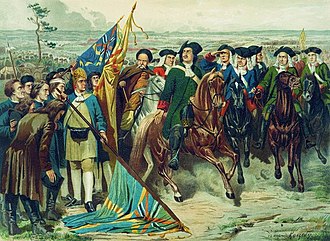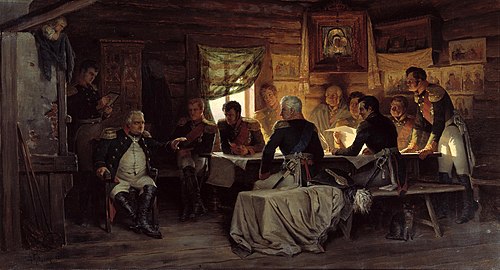Aleksey Kivshenko
Aleksey Kivshenko | |
|---|---|
| Алексей Кившенко | |
 Aleksey Kivshenko (1890s) | |
| Born | 22 March 1851 |
| Died | 2 October 1895 (aged 44) |
| Resting place | Smolensky Cemetery, Saint Petersburg |
| Education | Member Academy of Arts (1884) Professor by rank (1893) |
| Alma mater | Imperial Academy of Arts (1877) |
| Known for | Painting |
| Movement | Peredvizhniki[citation needed] |
| Awards | |
Aleksey Danilovich Kivshenko (Russian: Алексей Данилович Кившенко; 22 March [O.S. 10 March] 1851 – 2 October 1895) was a Russian painter, primarily of historical scenes. Among the best-known were those depicting the Russo-Turkish Wars. He also created hunting and genre scenes and was associated with the Peredvizhniki.
Biography
[edit]He was born on a small stud farm in Tula Governorate in the family of a serf of Count Sheremetev. His father was interested in art and music, so he encouraged his son's early attempts at drawing. His first studies began when he was nine; at the Imperial Society for the Encouragement of the Arts with Ivan Kramskoi.[1][2]
From 1867 to 1877, he was a student at the Imperial Academy of Arts, under the direction of Kārlis Hūns.[3] He also audited classes at the State Institute of Technology and the Medico-Surgical Academy, but these were not to his liking. While there, he helped support himself by working as a scribe for the Admiralty Board.[4]
In 1880, after receiving a foreign fellowship, he began to travel extensively, visiting Paris, Düsseldorf and Munich, where he worked with Gabriel von Max and Wilhelm von Diez.[3] When he returned in 1884, the paintings he had produced earned him the title of "Academician". Later that year, he was commissioned by Tsar Alexander III to create scenes from the recent Russo-Turkish War, so he went to Transcaucasia to make sketches. He also taught drawing at the Saint Petersburg Art and Industry Academy until 1889.[1]
In 1891, he accompanied Nikodim Kondakov on an archaeological expedition to Palestine and Syria, returning with numerous sketches of everyday life in the region, as well as the ancient buildings.[1] Many of these were used as book decorations. In 1893, he became a full member of the Academy and taught a class in battle painting.[3] He died of undisclosed causes during a visit to Germany.
Selected paintings
[edit]- Reading of the Russkaya Pravda for the people in the presence of Grand Prince Yaroslav
- Minin's Proclamation to the Nizhegorodians
- Election of Mikhail Fyodorovich Romanov to the Tsardom
- Patriarch Nikon Revising the Service-Books
- General Kutuzov at the Council of Fili; his best known work. The other participants are identified on the file in Wikimedia Commons
- The entry into Paris in 1814 (aftermath of Battle of Paris (1814))
- Imam Shamil Surrendering to Count Baryatinsky
References
[edit]- ^ a b c Brief biography @ Russian Painting.
- ^ Aksyonova, G. V. (8 August 2015). "Христианские святыни в творчестве русских художников и паломников". Imperial Orthodox Palestine Society. Retrieved 2024-04-28.
- ^ a b c Biographical notes Archived 2019-03-29 at the Wayback Machine @ RusArtNet.
- ^ Brief biography @ LiveJournal.
Further reading
[edit]- Matafonov, Vadim S. (1971). "Алексей Данилович Кившенко". In Leonov, Alexei I. (ed.). Русское искусство: очерки о жизни и творчестве художников. Вторая половина девятнадцатого века (in Russian). Vol. 2. Moscow: Iskusstvo. pp. 339–346. OCLC 71538004.
External links
[edit]- Biographical notes and more paintings @ Воскресный день
- Russian archaeologists in Jericho @ Императорского Православного Палестинского Общества (Imperial Orthodox Palestine Society).


 French
French Deutsch
Deutsch


![Dolobskoye Congress [ru]](http://upload.wikimedia.org/wikipedia/commons/thumb/2/2b/Congress_in_Dolobsk_1103.jpg/330px-Congress_in_Dolobsk_1103.jpg)













![Storm of Gorgokhotany Heights [ru]](http://upload.wikimedia.org/wikipedia/commons/thumb/8/81/Gorgokhotany.jpg/250px-Gorgokhotany.jpg)
